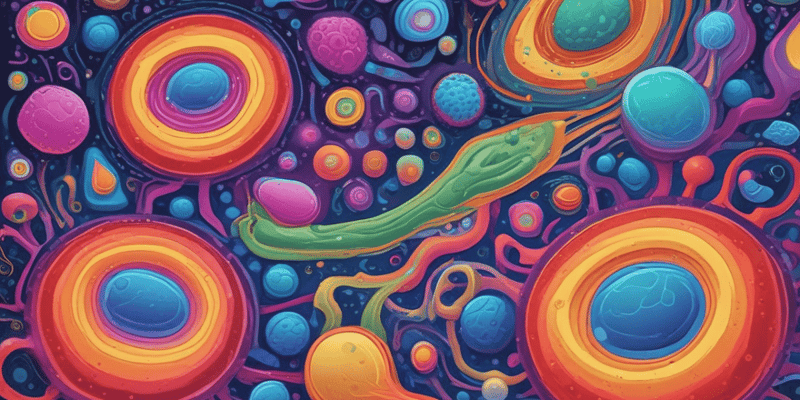29 Questions
What is the primary function of the cell membrane in terms of physical separation?
To separate intracellular fluid from the surrounding extracellular fluid
What is the role of proteins in the cell membrane in terms of communication?
To enable the cell to recognize and respond to molecules or changes in its external environment
What is the function of the cell membrane in maintaining cell shape?
Structural support to the cytoskeleton
What is the primary function of structural channels in the cell membrane?
To allow water-soluble substances to diffuse through
What is the general function of the cell membrane that involves the control of substances entering and leaving the cell?
Regulation of exchange with the environment
What is the main function of carrier proteins in the cell membrane?
To transport substances in the direction opposite to their electrochemical gradients
What is the component of the cell that contains DNA and directs cell activities?
Nucleus
What is the primary function of membrane carbohydrates?
To repel negatively charged substances
What is the result of any alteration in the cell membrane?
The cell's activities are affected
What is the significance of the glycocalyx in some cells?
It attaches cells to one another
What types of substances can easily penetrate the lipid layer of the cell membrane?
Fat-soluble substances, such as oxygen and carbon dioxide
What is the function of proteoglycans in the cell membrane?
To act as receptors for hormone binding
What is the primary function of aquaporins in the cell membrane?
To facilitate the rapid passage of water through the membrane
What is the direction of movement in active transport?
From an area of low concentration to an area of high concentration
What is the energy source for primary active transport?
Breakdown of adenosine triphosphate (ATP)
What type of transport involves the movement of molecules with the concentration gradient?
Facilitated diffusion
What is the function of the sodium-potassium pump?
To move sodium ions out of the cell and potassium ions into the cell
What is the characteristic of secondary active transport?
Energy is derived from ionic concentration differences
What is the function of lysosomes in cells?
To remove damaged portions of cells
What is the pH of the acid present in lysosomes?
pH 5.0
What is the process called when intracellular components and dysfunctional organelles are delivered to the lysosome for degradation and recycling?
Autophagy
What is the ultimate fate of worn-out cell organelles inside the lysosomes?
They are digested and the nutrients are reused by the cell
What is the significance of autophagy in cells?
It contributes to the routine turnover of cytoplasmic components
What is the main characteristic of a selectively permeable membrane?
It allows only certain substances to pass through.
What type of transport does not require energy expenditure?
Passive transport
How do carrier proteins facilitate diffusion?
By interacting with molecules to help them cross the membrane
What determines the rate of facilitated diffusion?
The amount of substance available, the velocity of kinetic motion, and the number and sizes of openings in the membrane
What type of channel protein changes conformation in response to a signal?
Chemically gated channel
What is the function of membrane receptors?
To receive and transmit signals
Study Notes
Lysosomes
- Function as the digestive organs of cells, responsible for removing damaged portions of cells and exhibiting bactericidal effects
- Contain agents such as lysozyme, lysoferrin, and acid (pH 5.0) to dissolve bacterial cell membranes, bind iron, and activate hydrolases
- Involved in recycling of cell organelles through autophagy, where intracellular components and dysfunctional organelles are delivered to the lysosome for degradation and recycling
Autophagy
- Process in which organelles and large protein aggregates are degraded and recycled
- Contributes to the routine turnover of cytoplasmic components and is a key mechanism for tissue development and cell survival
Cell Membrane
- Principal parts of cells include the plasma membrane, cytoplasm, and organelles, and the nucleus
- Functions of the cell membrane include physical isolation, regulation of exchange with the environment, communication between the cell and its environment, and structural support
Membrane Proteins
- Categorized into integral proteins and peripheral proteins based on their structure and function
- Functions include membrane transport, structural support, enzyme activity, and receptor activity
- Examples include carrier proteins, channel proteins, membrane enzymes, and membrane receptors
Cell Transport Systems
- Cell membranes are selectively permeable, allowing certain substances to pass through while restricting others
- Passive transport involves the movement of substances into or out of the cell without energy expenditure, including diffusion and facilitated diffusion
- Active transport involves the movement of substances into or out of the cell with energy expenditure, including primary and secondary active transport
- Examples of active transport include the sodium-potassium pump and calcium pumps
This quiz covers the functions of lysosomes, including the removal of damaged cell portions, bactericidal effects, and recycling of cell organelles. It also delves into the agents involved in these processes, such as lysozyme and lysoferrin.
Make Your Own Quizzes and Flashcards
Convert your notes into interactive study material.
Get started for free



